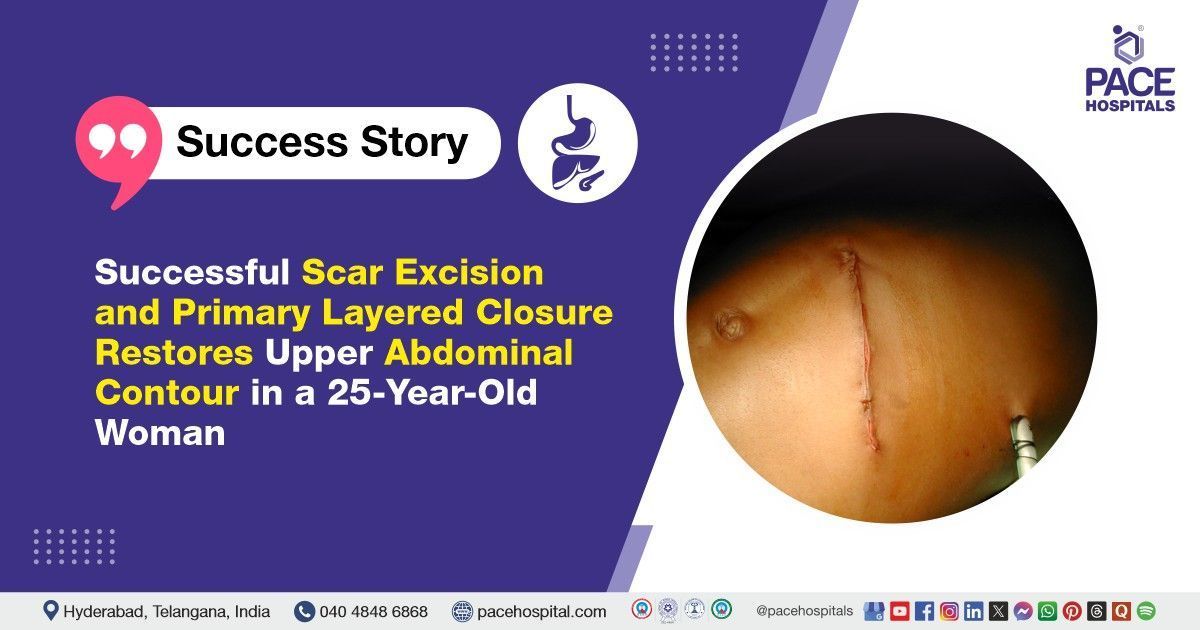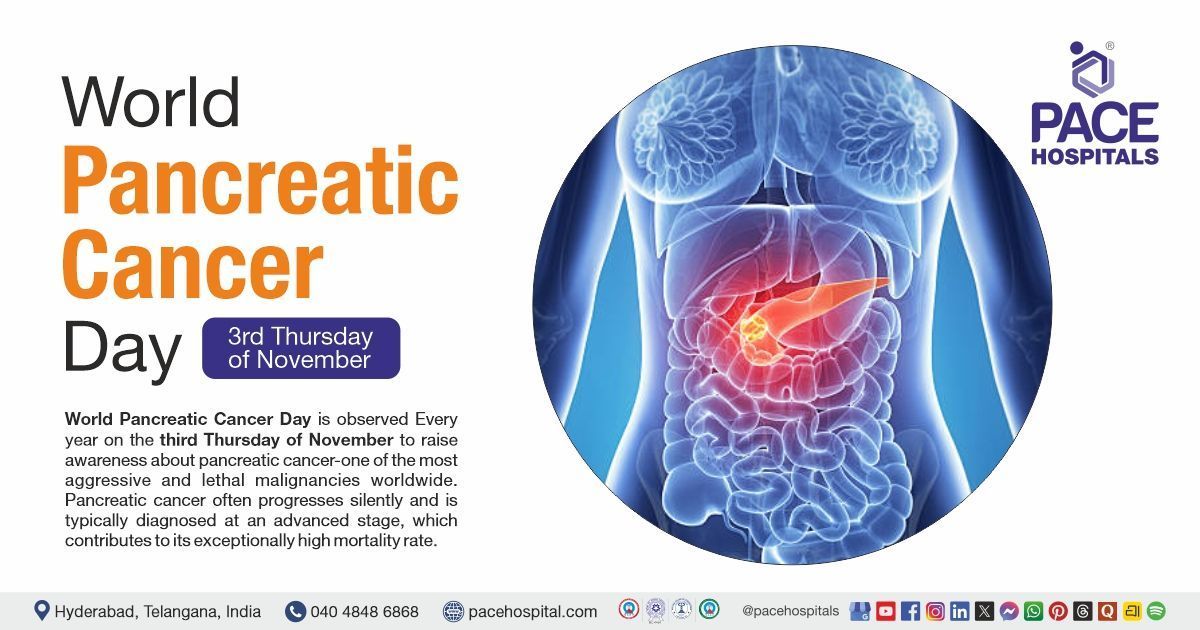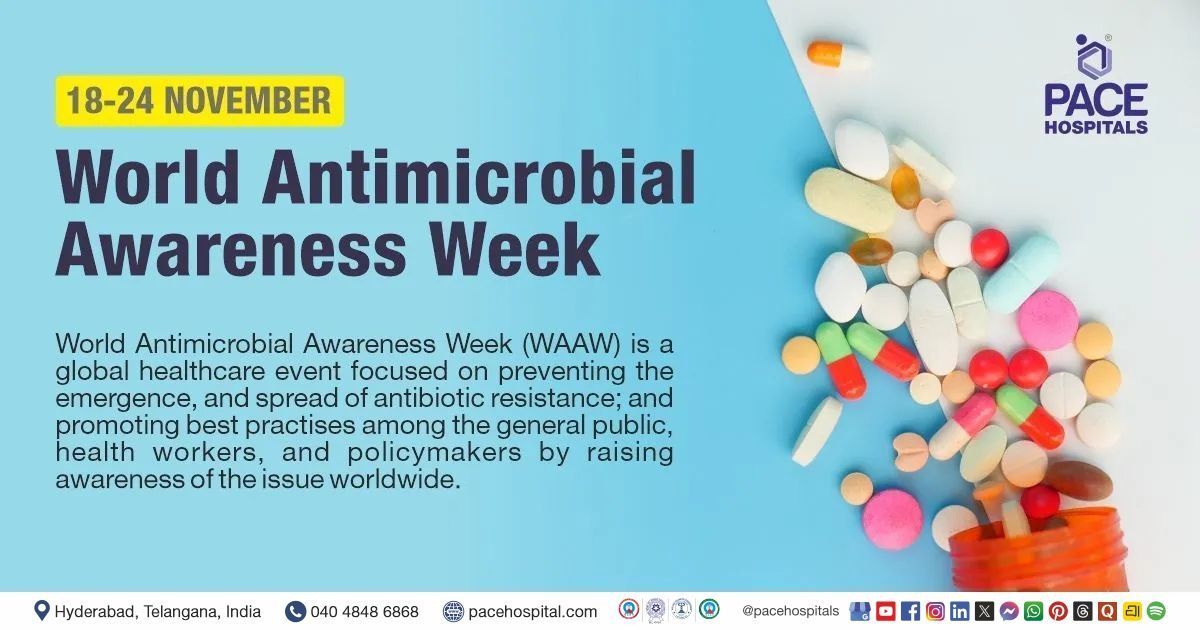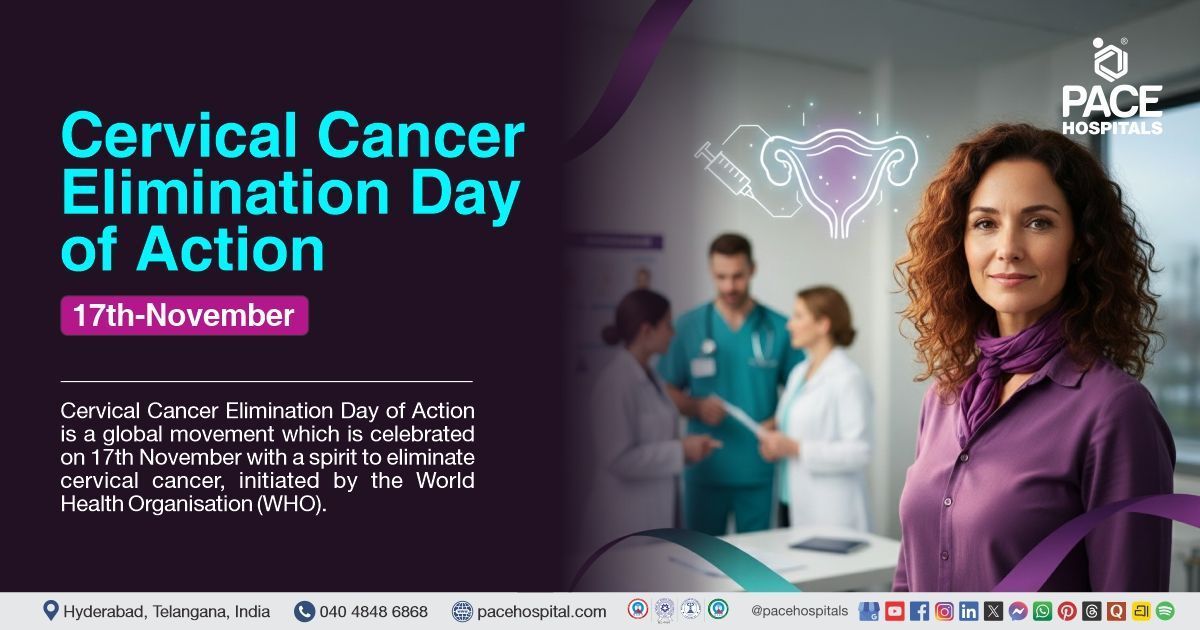Successful Scar Excision and Primary Layered Closure Restores Upper Abdominal Contour in a 25-Y.O Woman
PACE Hospitals
PACE Hospitals' expert Plastic and Reconstructive Surgery team successfully performed Scar Excision and Suturing on a 25-year-old female patient who presented with deformity and a tight scar over the upper abdomen secondary to previous surgery. The procedure was performed to remove the contracted scar tissue, restore abdominal contour, and improve the patient's appearance and comfort.
Chief Complaints
A 25-year-old female patient with a body mass index (BMI) of 19 presented to the Plastic and Reconstructive Surgery Department at PACE Hospitals, Hitech City, Hyderabad, with complaints of upper abdominal deformity secondary to a previous surgical scar. The patient reported associated tightness over the scar without any tenderness or active discharge.
Past Medical History
The patient had a history of prior surgery for a suspected congenital diaphragmatic hernia and no known drug allergies or medical illnesses reported.
On Examination
The patient was conscious, coherent, and cooperative. Her general condition was stable, with vital signs within normal limits. There was a tight, contracted scar with visible suture marks on the upper abdomen, causing deformity but no signs of infection or discharge. And no abnormal findings such as pallor, icterus, cyanosis, lymphadenopathy, clubbing, or pedal edema. No other abnormalities were detected on systemic examination.
Diagnosis
Following the clinical examination, the Plastic and Reconstructive Surgery team conducted a thorough assessment, including a detailed review of the patient’s medical and surgical history with presenting abdominal complaint. A focused evaluation of the scar contracture. X-rays were performed to rule out any underlying bony deformities or associated pathologies that could contribute to the abdominal deformity. Additionally, ultrasound and MRI scans were used to assess the soft tissue changes, including the extent of fibrosis and the depth of the scar tissue.
To confirm the diagnosis and determine the extent of scarring, the upper abdominal region was carefully examined. The assessment revealed a deformity of the upper abdomen secondary to scar contracture, with associated tightness. The scar was non-tender, and there were no signs of active discharge, infection, or systemic complications.
Based on the confirmed diagnosis, she was advised to undergo
Abdominal Deformity due to Scar Contracture Treatment in Hyderabad, India, under the care of the Plastic and Reconstructive Surgery team to restore the normal contour of the abdomen and relieve scar-related tightness.
Medical Decision Making
After a detailed consultation with Dr. Kantamneni Lakshmi, Senior Consultant Plastic, Reconstructive & Aesthetic Surgeon, A comprehensive evaluation was conducted focusing on the patient’s presentation of abdominal deformity secondary to scar contracture and the diagnostic findings. Clinical examination confirmed the presence of scar contracture over the upper abdomen, causing deformity and tightness. Surgical correction was deemed necessary.
It was determined that the patient had an abdominal deformity secondary to scar contracture, which resulted in significant contour irregularity and tightness. Scar excision and layered closure were identified as the most effective interventions to release the contracture, restore abdominal contour, and improve skin mobility.
The patient and her family were thoroughly counselled regarding the severity of the injury, the surgical procedure, potential risks, and the expected benefits aimed at relieving symptoms and preventing further complications.
Surgical Procedure
Following the decision, the patient was scheduled to undergo Scar Excision and Layered Closure in Hyderabad at PACE Hospitals under the supervision of the expert Plastic and Reconstructive Surgery Department.
The following steps were carried out during the procedure:
- Preoperative Preparation: The patient was taken to the operating room and placed under general anaesthesia. Standard aseptic precautions were strictly followed to maintain a sterile environment. The surgical area over the upper abdomen was thoroughly cleaned, painted, and draped in preparation for the procedure.
- Marking and Planning: The scar causing the deformity and contracture on the upper abdomen was carefully identified and marked. The surgical team confirmed the plan to excise the contracted scar tissue to release the deformity.
- Scar Excision: The marked scar tissue was meticulously excised. This step aimed to remove the fibrotic and tight scar tissue responsible for the abdominal deformity and contracture, allowing for improved skin flexibility.
- Undermining of Lateral Flaps: Adjacent skin and subcutaneous tissues were undermined effectively. This manoeuvre helped create mobility in the surrounding tissue, facilitating a tension-free closure of the wound without excessive stretching.
- Hemostasis: Bleeding was carefully controlled throughout the surgery using cautery and ligatures. This ensured a clear surgical field and helped minimize the risk of postoperative bleeding and complications.
- Layered Wound Closure and dressing: The wound was closed in three distinct layers. The deep layer was approximated using absorbable sutures. The subcutaneous and dermal layers were then closed, followed by the skin closure performed with non-absorbable sutures, ensuring proper healing and minimal scarring. A sterile and aseptic dressing was applied over the closed wound to protect the site and prevent infection. The patient was subsequently monitored in the recovery area.
Postoperative Care
The postoperative period was stable and uneventful. She received intravenous antibiotics, analgesics, and gastric acid suppressants. Wound hygiene was maintained with aseptic dressings, and the surgical site appeared healthy with no signs of infection or complications. The patient tolerated oral intake well and was discharged in stable condition with follow-up instructions.
Discharge Medications
At the time of discharge, the patient was advised to take an oral antibiotic to prevent postoperative wound infection and promote healing. A topical antibiotic ointment was prescribed for local application to maintain wound hygiene and reduce the risk of superficial bacterial contamination. A proton pump inhibitor was included to minimize gastric irritation associated with the use of antibiotics and analgesics. An oral analgesic was advised to manage postoperative pain and discomfort. In addition, a multivitamin tablet was recommended to support overall recovery and nutritional status. Pain relief medication was prescribed on an as-needed basis for breakthrough pain.
Advice on Discharge
The patient was advised to maintain proper wound care with regular dressings. Avoid lifting heavy weights to prevent strain on the healing area. Wearing an abdominal binder was recommended to provide support and promote healing.
Dietary Advice
The patient was advised to follow a regular diet to support overall recovery. Emphasis was placed on consuming a balanced variety of foods rich in proteins, vitamins, and minerals to promote healing. She was encouraged to stay well hydrated and maintain regular meal patterns while avoiding excessive sugar and processed foods.
Emergency Care
The patient was informed to contact the emergency ward at PACE Hospitals in the event of any emergency or the development of symptoms such as fever, abdominal pain, vomiting, swelling, pain at the surgical site, or signs of allergic reaction.
Review and Follow-up Notes
The patient was advised to return for a follow-up consultation with the Consultant Plastic, Reconstructive & Aesthetic Surgeon in Hyderabad at PACE Hospitals five days after discharge for wound evaluation and dressing change, with a prior appointment.
Conclusion
This case highlights the successful management of abdominal deformity secondary to scar contracture through timely surgical intervention with scar excision and layered closure. The patient demonstrated good postoperative recovery with stable vital signs and no complications. Proper wound care and follow-up were emphasised to ensure optimal healing and restoration of abdominal contour and function.
Comprehensive Care in Upper Abdominal Scar Contracture Repair
Successful management of upper abdominal scar contracture involved precise surgical excision of the contracted scar tissue followed by meticulous layered closure under general anesthesia to restore the normal abdominal contour and skin flexibility. The surgery aimed to release the tight scar, minimize tissue damage, and ensure optimal wound healing. Postoperative care emphasized maintaining wound hygiene, administering systemic antibiotics, and controlling pain to prevent infection and complications.
Integrated care from the
Plastic surgeon / Plastic surgery doctor ensured comprehensive treatment throughout the patient’s recovery. Patient education on wound care, activity modification such as avoiding heavy lifting, and adherence to follow-up schedules were critical to achieving the best functional and cosmetic outcomes. This multidisciplinary approach was essential for promoting healing, restoring abdominal form and function, and enhancing patient satisfaction.
Share on
Request an appointment
Fill in the appointment form or call us instantly to book a confirmed appointment with our super specialist at 04048486868











